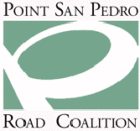Forgive me for the length of this post, but it is difficult to fully explain what is happening in just a few words. To keep my typing finger from tiring, I will use some abbreviations: PSPR (“Pt. San Pedro Road”), EB (“east bound” on PSPR), WB (“west bound” on PSPR), and NS (“north-south” on the cross street to PSPR) The latter would be Loch Lomond Drive in The Strand and Lochinvar Road in Loch Lomond.
To bring everyone up-to-date on the issue of signal timing at this intersection, I have been in conversation with Charmine Solla, Deputy Director of the S.R. Public Works Department (DPW). She has taken on the investigation of, and any correction to, the signal timing at this intersection. She went out Thursday December 7, once in the morning to meet with DPW’s signal contractor and once in the afternoon to meet with a Caltrans Traffic Engineer. As a result of DPW’s visit to the site, certain timing settings have been changed. However, there is a break in the system that needs to be repaired, so the signal will not operate quite as intended until then. More on that in a moment.
Pardon me for a bit of “techie talk” here, but it will help to understand the situation. Imbedded in the roadway are traffic detectors which communicate with the signal controller, which is programmed to control the traffic signal timing. On PSPR, there are two detectors in each lane in each direction approaching the intersection; advanced detectors that are about 200-230 feet from the intersection and limit line detectors just before the intersection. On the NS roadways, there are only limit line detectors, no advanced detectors.
Trust me, this all becomes important!
The basic setting when there is no NS or pedestrian traffic is that the signal will remain green for PSPR. The minimum length of time the signal is green for PSPR is 15 seconds and the maximum is 40 seconds (but only if a vehicle has tripped the NS limit line detectors). A “gap time” is set for the expected length of time for a vehicle to travel from the advanced detector to the limit line detector based on the speed limit on the roadway. The gap time on PSPR is set to 3.5 seconds. The way this works is that each time the advanced detectors are tripped on PSPR while the signal is still green on PSPR, that green is extended by 3.5 seconds to allow that vehicle to transit the intersection (i.e., the time goes from 15 seconds to 18.5 seconds to 22 seconds, etc.) up to a maximum of 40 seconds – or longer if no vehicles have tripped the NS limit line detectors.
Here is where the system break comes in. PG&E, apparently during some roadwork, cut the connections from all the advanced detectors in westbound PSPR so they do not communicate with the signal controller. That means that vehicles are only detected in that direction when they tripped the limit line detectors. If not already green, the signal will turn green for PSPR, but only for the minimum 15 seconds with none of the extensions discussed above (except, of course, if there is no NS traffic). Then the signal might change to green NS if those detectors are tripped, UNLESS there is also traffic eastbound on PSPR tripping the detectors there. Until this is fixed, westbound PSPR traffic will experience more stop-and-go traffic than desired. This is likely to happen during morning commute when there is heavier westbound PSPR traffic and light eastbound PSPR traffic.
For NS traffic, the minimum time the signal is green is 9 seconds and the maximum is 20 seconds. If a vehicle trips the NS limit line detectors, the signal changes to green NS only after the timing has expired on PSPR (see above paragraph). The limit line detector here is about 20 feet from the intersection. So long as vehicles are detected within the limit line detector space, the signal will remain green NS up to a maximum of 20 seconds before returning to green on PSPR. That would accommodate up to approximately 4 vehicles waiting in the NS direction.
The actual signal operation is complex, but one way to look at it is that, if there is simultaneously heavy traffic in all directions at this intersection, the signal could be green on PSPR for 40 seconds and then green on NS for 20 seconds until returning to PSPR. Otherwise, it will be mostly green on PSPR.
One last caveat: Pedestrians must push the pedestrian push button if they wish to cross PSPR. If pedestrians do not push the pedestrian button, they won’t receive enough time to cross the entire length of PSPR and will most likely have to wait in the median. When a pedestrian pushes the button, it is similar to when a vehicle trips the limit line detector except the length of the NS green is 23 seconds instead of 9 seconds before the signal goes back to green on PSPR. It is highly unsafe if pedestrians do not use the button and rely on a NS vehicle to trip the signal because the crossing time would be too short. If that became the norm, DPW could be forced to increase all the minimum and maximum times to the detriment of vehicular traffic.
I hope this was reasonably understandable and not too convoluted. I will try to keep everyone up-to-date when we know the schedule for PG&E to fix the connectors to the advanced detectors in the westbound lanes of PSPR.
Alan Schaevitz
Board Member and Webmaster
Pt. San Pedro Road Coalition
